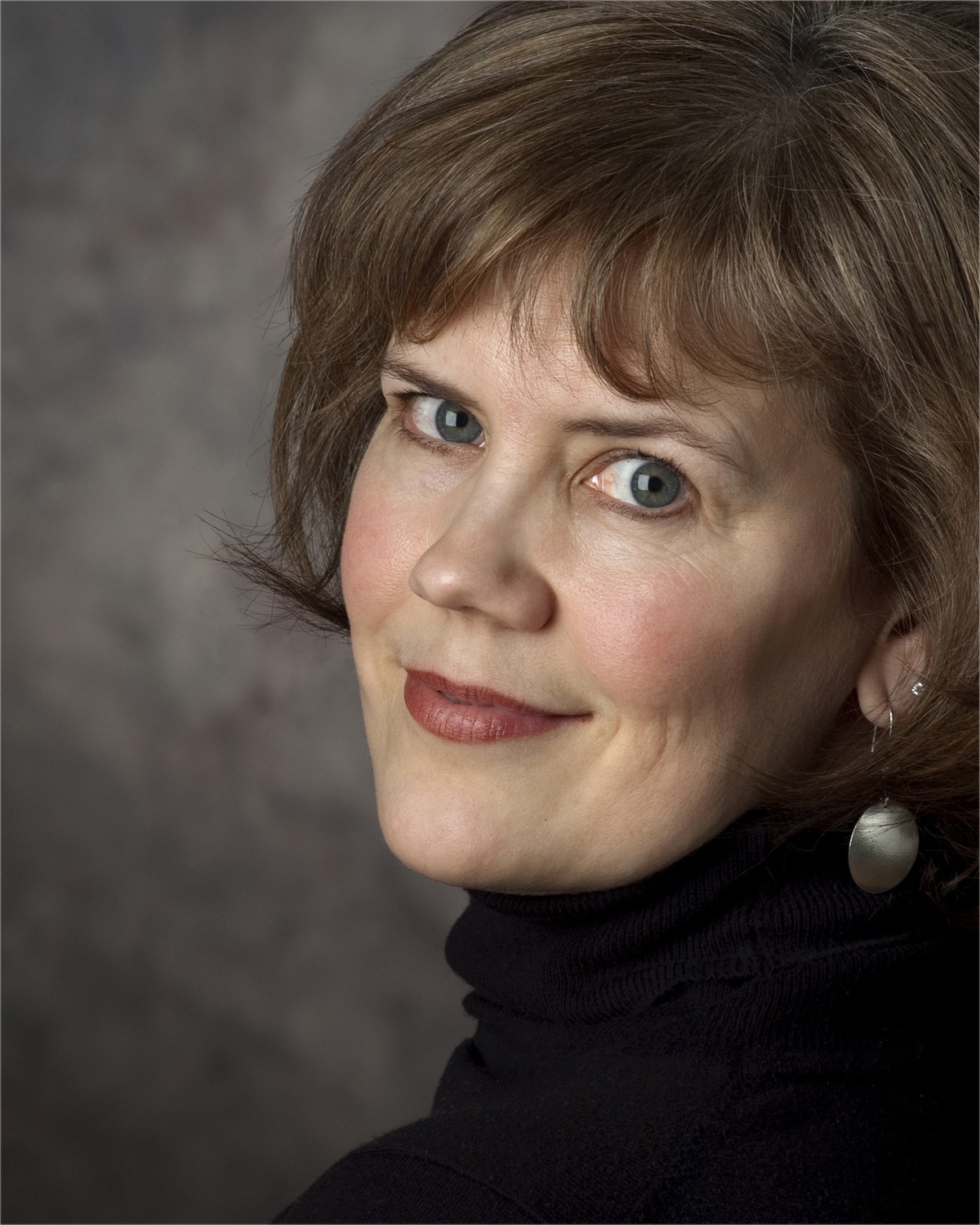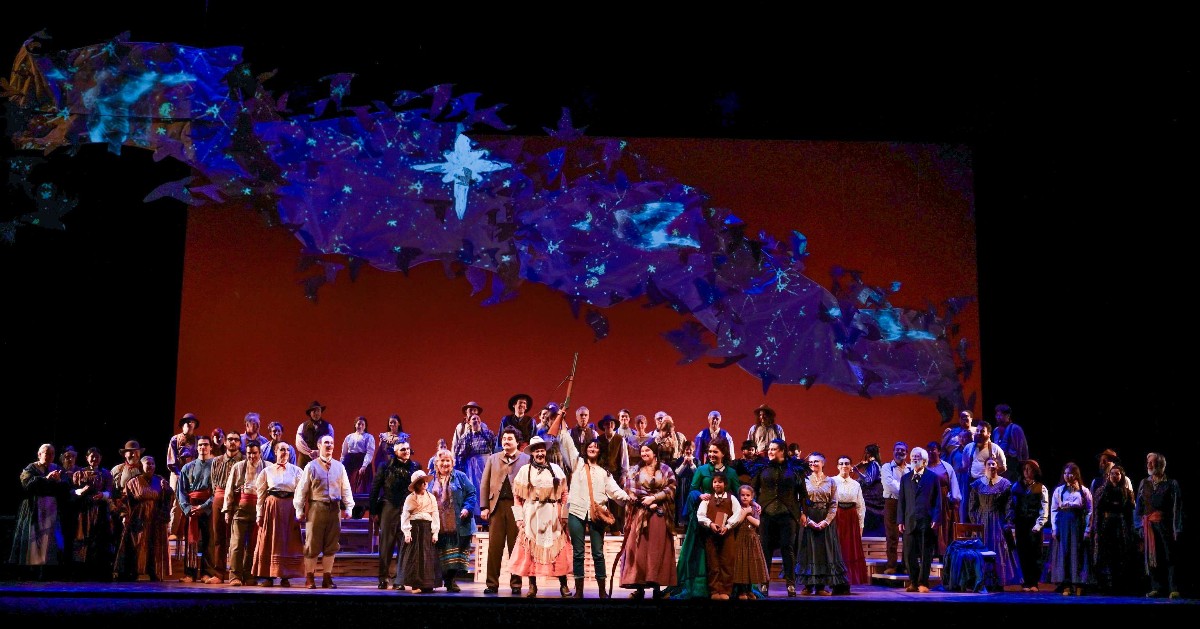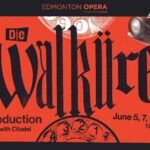Manitoba Opera marked a significant milestone in Canadian opera history as it launched its 51st season with the first full-scale Indigenous-led opera presented on a national mainstage, Li Keur: Riel’s Heart of the North. The 135-minute (including intermission) opera based on a libretto by Vancouver based Métis poet/storyteller Suzanne Steele, and co-composed by Métis fiddler Alex Kusturok and Canadian-Mennonite University music professor Neil Weisensel is ostensibly a love letter to the Métis nation, as well as joyous celebration of its women and culture, with Michif leader Louis Riel providing salient counterpoint throughout.
The production stage directed by Simon Miron (MO debut) also served as a showcase for Indigenous heritage languages, with its cast of 11 principals, adult/children choruses slipping among five languages including Southern Michif, French-Michif, and Anishinaabemowin, as well as French and English (with English surtitles).
Suzanne Steele’s highly imagistic, poetic narrative, which moves from 1870s Montana through to the 21 st century, unfolds through an episodic series of dream-like sequences. Josephine-Marie (actor Charlene Van Buekenhout), a feisty, modern day Métisse student struggling with writing an essay on decolonization and self-location, tells her beloved grandmother Memere (actor Paulette Duguay; notably an actual descendent of Riel’s), who appears during her dream, that she doesn’t want to “carry the burdens of our nation.” More chillingly, she declares “I pass for ‘white’ and that makes everything so much easier.” She also rails against the legacy of Riel; Steele immediately addresses the generations-old controversy that still swirls around the visionary maverick, now recognized as the father of Manitoba, and immortalized in Harry Somers’s 1967 opera Louis Riel based on Mavor Moore and Jacques Languirand’s libretto.
There were many compelling moments ringing with truth in this show, with its cast of characters brought to life by singers, dancers, actors and musicians who have these stories in their blood and bones.
Mezzo-soprano Rebecca Cuddy crafts young Métisse sharpshooter Josette La Grande who falls hard for Riel – now disguised as “Baptiste Robideau,” on the run from assassins – as a fiercely independent heroine in search of her own destiny, after her father, Pierre La Grande (bass-baritone David Watson) sells her as chattel to crusty trader Jacques La Crosse (tenor James McLennan).
Audible gasps in the audience were heard when Anishinaabe lyric baritone Evan Korbut first came onstage as the 28-year old Riel, seemingly brought back to life mere days after the 138th anniversary of his execution on November 16, 1885, that further heightened Li Keur’s (“the heart”) ghostly overtones. His opening aria in which he sings “O Spirit of God, give me the guts of the North” immediately displayed his robust vocals and well-nuanced characterization, showing us Riel’s own complex heart torn between love, faith, and destiny.
Soprano Keely McPeek also compelled as Marie Serpente, Josette’s childhood friend/confidante who joins her with her own lover and Riel’s guide partner, tenor Nolan Kehler’s La Roche. Her administering to the fallen as an Anishinaabeg knowledge keeper and medicine woman became emblematic of the power and wisdom of women to heal the deep wounds of the world, with McPeek’s sensitive portrayal providing gravitas. The Black Geese of Fate (mezzo-soprano Michelle Lafferty and tenor Scott Rumble) that serve as the opera’s chief protagonists swoop into Riel’s life as agents of change. These inherently dramatic figures, flanked by a six-member Black Geese dance ensemble might have played a darker, more intense role as they propel the storyline forward. Special mention must be made of Canadian dance artist’s Jera Wolfe’s mesmerizing duet choreographed by Yvonne Chartrand, and performed upstage with local contemporary dancer Elise Page, mirroring with balletic grace the two lead characters as Josette sings of her passion for Riel/Robideau.
The versatile McLennan also appeared as a generically monikered Englishman, who lusts after Josette, and wishes to possess her while travelling with Riel’s buffalo brigade. His larger-than-life portrayal symbolized dark colonial forces in this country that sought to whitewash Indigenous culture and identity. An abundance of spoken narration/dialogue in lieu of typically sung recitative, while helpful in clarifying shifts between vignettes, inadvertently diffused the opera’s overall dramatic tension and forward thrust. Some scenes could also have been whittled—or cut completely—to help sharpen the narrative’s focus.
One can never have too much jigging in this world, with a group of ebullient dancers lighting up the stage during their all-too-brief appearances, accompanied by an onstage Black Geese band comprised of Kusturok, fiddler Melissa St. Goddard and guitarist Jordan McConnell.
In what surely marks a career highlight, Weisensel led the Winnipeg Symphony Orchestra through his own orchestral score grounded in contemporary musical vernacular that is strong and sure. His music proved at its most lyrical best during such poignant arias as Josette’s “Beneath the endless azure sky,” or later “You come and go,” sung to Riel, with many pieces that could easily become stand-alone concert works.
Steele’s lexicon in turn is unabashedly poetic, conjuring evocative images such as windflowers scattering in the wind, as a metaphor for Métis peoples forced to disperse throughout the diaspora—the idea of “coming home” trumpeted as a prominent theme in Li Keur—that ignites the imagination.
The show’s denouement, in which Josephine-Marie takes full ownership of her Michif heritage, in tandem with Josette’s inheriting symbolic gifts as Riel is sentenced to die (while his deceased wife, soprano Julie Lumsden’s Margueritte watches on) could be fleshed out more fully. However the stage triumphantly filling with the entire, multi-generational cast belting out, “We are the guts and the heart of the North” is powerfully moving, on par with MO’s 2014 production of Beethoven’s Fidelio in which real-life refugees similarly flooded the stage singing of freedom.
The 1.2 million dollar production including MO’s extensive community engagement activities boasted a striking set of a Métis infinity symbol with risers (albeit only completely visible from the hall’s upper balconies and lodges) designed by T. Erin Gruber, who also created animated digital projections including geese, dragonflies, bead-work, and bison. The show rounded out with Deanne Finnman’s traditional costumes with Scott Henderson’s lighting at times too dim.
In addition to celebrating Michif culture, Li Keur more largely marks a pivotal step forward in the ongoing journey of reconciliation with Canada’s Indigenous Peoples.
Many there in opening night’s sold out audience were likely witnessing the historically Euro-centric art form for their first time, while seeing themselves represented onstage by opera singers also wearing moccasins, colourful Métis sashes and buckskin jackets. As expected, the enthralled crowd leapt to its feet at the end as the full stage of performers burst into a Red River jig—this music the very lifeblood of Métis culture.
Whether or not Li Keur: Riel’s Heart of the North can, or will ever be produced again in future, either in Manitoba or elsewhere across Turtle Island given its unique casting requirements, remains a moot point. Manitoba Opera’s ambitious world premiere marks a seminal point in time, that reverberates with the Black Geese’s bold imperative to Riel: “The future is now.”
Related Content ↘
Opera Canada depends on the generous contributions of its supporters to bring readers outstanding, in-depth coverage of opera in Canada and beyond. Please consider subscribing or donating today.

Holly Harris has served as an opera, classical music, dance and theatre critic for over 20 years, including having written for Opera Canada since 2009. A Prairie girl at heart, her reviews and articles have also appeared in the Winnipeg Free Press, Ludwig van Toronto, Musicworks, Opera Today, Classical Voice North America, Dance International, The Dance Current, Symphony, and The Strad.










